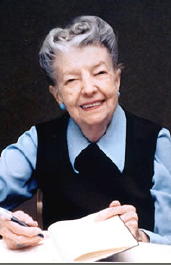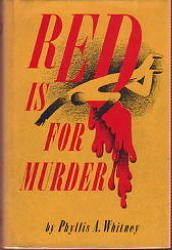Sat 9 Feb 2008
Obituary: PHYLLIS A. WHITNEY (1903-2008).
Posted by Steve under Authors , Obituaries / Deaths Noted[5] Comments

I have sad news to report. There is an obituary in today’s New York Times for one of the mystery field’s grandest ladies, Phyllis A. Whitney. The following is the mini-biography that appears in A COMPLETE SET OF FINGERPRINTS: An Annotated Checklist of the Fingerprint Mystery Series published by Ziff-Davis, by Bill Pronzini, Victor Berch & Steve Lewis:
Of the various authors who wrote books for the Fingerprint line, Phyllis A. Whitney may not have the honor of having written the most books in her career – that honor goes to Judson Philips / Hugh Pentecost – but the time span involved in her case is surely the longest. Red Is for Murder was her first work of adult fiction, published when she was 40 years old. The most recent of her approximately forty novels is Amethyst Dreams (Crown, 1997), which was published when she was 94. That book is still in print, as are many of her earlier ones. [FOOTNOTE.]
In 1988 the Mystery Writers of America gave Ms. Whitney their Grand Master award for lifetime achievement, the highest honor they can bestow. As for the type of story on which her reputation is based, she is an author whom the New York Times once called the “Queen of the American Gothics.” Last year [2006] at the age of 102, it is reported, she was working on her autobiography. (The link will take you to her home page.)
For several years after Red Is for Murder, Whitney concentrated on children’s fiction. (Her first book, A Place for Ann (1941) was also in the young adult category.) Her next adult mystery, The Mystery of the Gulls, did not appear until well after the war was over, in 1949. The majority of the titles for which she is best known were published in the 1960s through the 1980s.

The jacket blurb for Red Is for Murder reads in part as follows: “How does it feel to be in a big [Chicago] department store after the customers have hurried home and the lights have been darkened so that eeriness reigns over the vast reaches of the floors? To Linell Wynn, who writes sign copy for Cunninghams’, such a scene has always seemed perfectly natural until the day that murder walks the floors at dusk.
“The matter-of-factness of the police as they question people whom she knows, works with every day, does nothing to dispel the feeling that they are only temporarily holding back the powers of darkness. Evil has struck once – and evil is hovering, waiting to strike again [and soon] she stumbles upon death for the second time.”
FOOTNOTE. Phyllis A. Whitney was born in Yokohama of missionary parents. Her middle name is “Ayame,” which is the Japanese word for “iris.” Her mother’s first marriage was to Gus Heege, who claimed to be the originator of the Swedish dialect play, his most famous being “Yon Yonson.” After Whitney’s father died in Japan, she and her mother returned to the US, where in 1920 (according to census records) she lived with her mother in the Devin household, where her mother worked as a maid. In 1930 as Phyllis Garner, she worked as a librarian in a circulating library in Chicago. She must have married George Garner around 1925, as she claimed to have been married for five years. For more information on her long and productive life, follow the link above to her home page.
[UPDATE] In a later post, mystery novelist and long-time fan Dean James shares with us his memories of Phyllis Whitney.
February 10th, 2008 at 7:17 am
Sad news.
I read “Red is For Murder” some years ago and might re-read it as kind of a tribute. I recall it was more HIBK than gothic and thus quite different from her later works. I also recall the setting was very well-done.
February 11th, 2008 at 10:40 am
Xavier, I’m sure your impression of “Red Is for Murder” is correct. (HIBK = “Had I But Known,” for the benefit of those who might be puzzled, a phrase which otherwise should be self-explanatory.) Even so, I have the feeling that it was a detective novel, and in that regard, as you say, quite different from her later books. Obviously she found her true voice later on.
—Steve
February 18th, 2008 at 3:48 am
Sad news indeed – but 104 is a good age.
I read tons of Whitney’s books when I was in high school more than 20 years ago – they made for great escapism during a less than happy time. I therefore remember them and her with great affection. What especially lingers was her wonderful sense of place. The settings and the way she wrote about them were often more interesting than the plots.
October 1st, 2009 at 4:35 pm
I have twenty-five of her books in hardcover and am re-reading them for the umpteenth time. As the years go by, I tend to forget how the story ends (I am 71)so I have to re-read them. She was the greatest romantic suspense novel writer! It was impossible to tell who the “bad guy” was until the end of the story.
April 8th, 2022 at 9:45 pm
I really enjoyed reading her juvenile mysteries but could not find many in the library where I grew up.
To her family enjoyed her books that I could get my hands on
Many Blessings to your family always